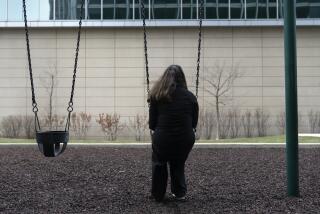Panic Attacks Afflict 1 in 75, Researchers Say : Health: Symptoms range from shortness of breath to a fear of going insane. Experts say that the often-misdiagnosed disorder is treatable.
- Share via
ROCKVILLE, Md. — One in 75 Americans suffers from attacks of fear severe enough to make some believe they are having heart attacks or losing their minds, but few are correctly diagnosed or treated, a panel of experts reported Friday.
Only one quarter of those who suffer from panic disorder receive proper treatment through medication or therapy, even though many have seen 10 or more doctors, the panel said at the conclusion of a three-day conference sponsored by the National Institutes of Health.
“Most primary care physicians don’t recognize this illness” and therefore treat it improperly, said Dr. Marsha Linehan, a psychology professor at the University of Washington and one of 13 health care professionals on the NIH panel.
The researchers said that “an aggressive educational campaign” is needed to inform doctors, patients and their families--and the public--about the disorder.
Panic disorder is characterized by recurring attacks of fear that are not triggered by specific circumstances, such as riding in an elevator or seeing a snake, as with other phobias. Symptoms include shortness of breath, dizziness, increased heartbeat, chest pain, fear of dying and fear of going insane. The attacks usually last about 10 minutes.
Some sufferers develop agoraphobia, the fear of being in a public place. Those with extreme agoraphobia can become housebound.
A person who has four or more panic attacks in one month is considered to have panic disorder. One who has fewer attacks but lives in constant fear of a recurrence may also be diagnosed as having the disorder. People who experience isolated panic attacks do not necessarily require treatment.
“The phenomenon of having an attack is a lot more common than what we characterize as the disorder,” said Dr. Layton McCurdy, dean of the Medical University of South Carolina and the conference chairman.
The disorder, which is found throughout the world, usually begins in adolescence. For unknown reasons, it occurs more frequently in women. Many sufferers have a family history of the disease, but researchers said that stress, illness, surgery, pregnancy and high caffeine use may trigger the disorder.
Although doctors have recognized the disorder since the 1960s, this week’s NIH conference is the first time that an official panel of experts has agreed that it is treatable.
Treatments include the use of antidepressant drugs as well as cognitive-behavior therapies in which patients are taught to overcome the panic by talking about it and being exposed to fearful situations. Combinations of the two treatments are being explored.
Relapses have been less frequent for patients who undergo cognitive-behavior therapy than for those who are treated by medication, the researchers reported.
“The relapse rate with cognitive-behavior therapy is very encouraging, very strong. It looks like it will be better than the results we’ve had with medication,” McCurdy said. He added, however, that the research is relatively new.
“This is really exciting. A consensus has been reached that this is a serious disorder,” said Jerilyn Ross, president of the Anxiety Disorders Assn. of America. “What’s come out of here is that we know there are effective treatments. We just don’t know which treatments are right for which people,” Ross said.






